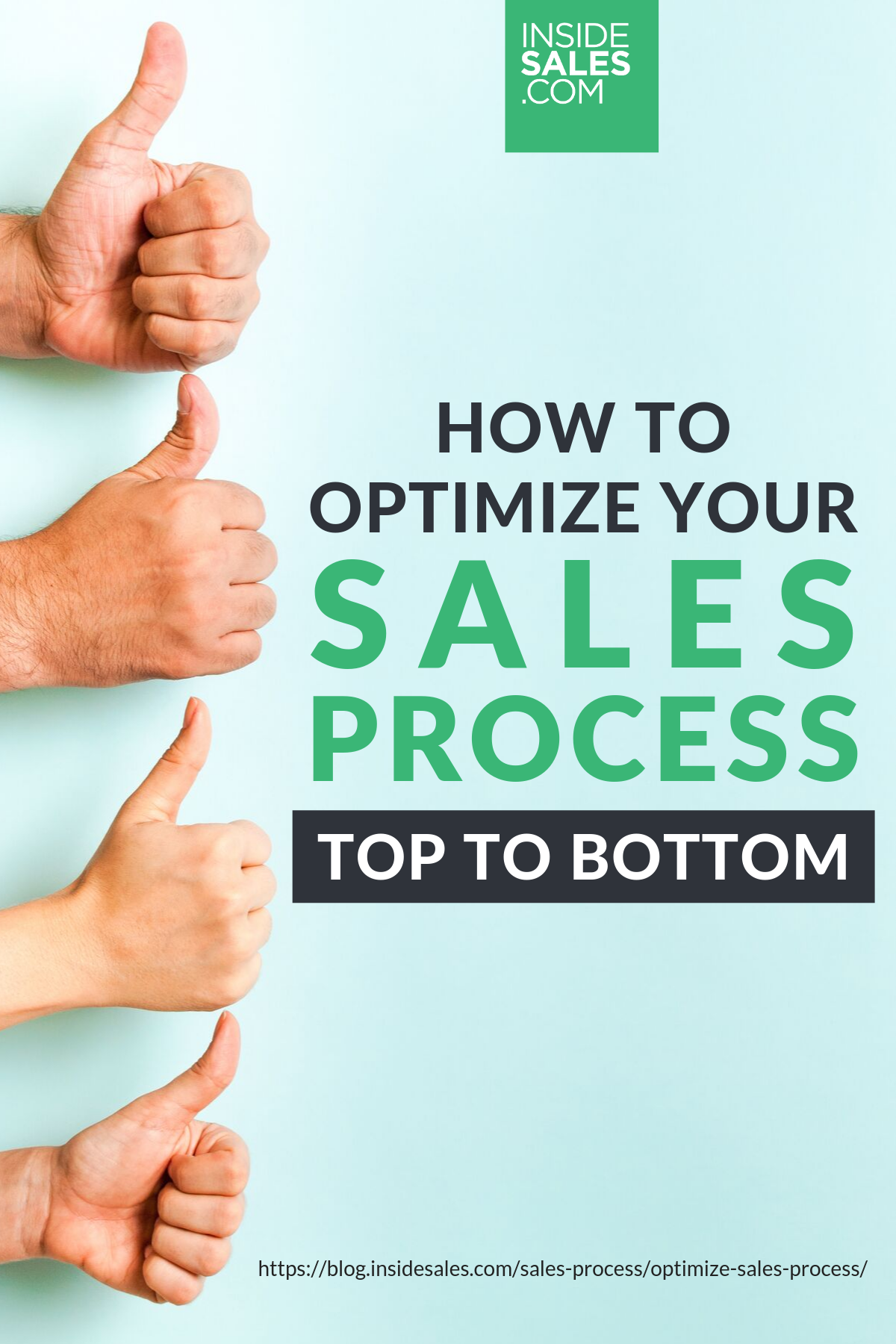How To Optimize Your Sales Process Top To Bottom
In this episode of Sales Secrets, I talk about how to optimize sales process and, more importantly, how to do it right, from top to bottom. Keep reading to learn more.
RELATED: What Role Content Plays in the Sales Process w/Dave Koslow @DocSend
In this article:
- How to Optimize Sales Process from Top to Bottom
- Understand Your Goals
- The Foundational Elements of a Good Sales Process Design
- Process Map
- Governance
- First Call Sequence Enablement
- Stage Two Criteria
Ways to Optimize Sales Process
How to Optimize Sales Process from Top to Bottom
A lot of sales organizations really struggle in trying to get the nuts and bolts down on the sales process flow. Nobody likes to talk about them because they’re so detailed.
If your organization isn’t getting into the detailed ways to optimize the sales process, you’re going to miss when it comes to figuring out what’s working or not.
People have asked me before about setting up a good structure. In order to win at a high level, the number one thing you have to remember is you have to understand your goals.
What are you ultimately trying to hit? Personally, I hate it when people walk me through a process without talking about the big picture.
Aside from that, there are three ways to optimize sales process. First is to lay a foundation where you define your basic elements.
Then, you need to map your entire process. Lastly, you move into governance where there are some reporting and enablement elements.
At a high level, those are the sales optimization techniques you should apply from top to bottom.
Understand Your Goals
In talking about the sales process, I want people to show me the big picture, first and foremost. This means figuring out your annual contract value (ACV) goal and the number of inbound or outbound marketing contacts you need to hit in order to meet that.
Next, I want to know what the sales-qualified lead (SQL) is. This is the middle part of the funnel that organizations need to go after.
Think about what your enterprise market looks like as well. If you know your overall number and you can’t break it down by marketing and sales, you’re at a miss.
We expect marketing to attribute 40% of the pipeline, while sales gets 60%.
How does sales break that down? Stage two, or the sales qualified opportunity (SQO), can be a very important part of that.
Know your numbers and break them down for marketing and sales if you can. Don’t simply say you need to hit $100 million for your segment.
Break it down further into the number of SQOs and marketing contacts that amount translate to. Those will then become your Marketing and Sales teams‘ goals.
The Foundational Elements of a Good Sales Process Design
Let’s move onto the process and how to optimize sales process. We use SiriusDecisions — they’re a great consulting and analyst firm, and experts in sales and marketing optimization.
SiriusDecisions provides a framework to have a conversation. You can take their framework and customize it for your own needs.
They also give you ideas on how to structure your waterfall, or your pipeline, from top to bottom. They call it the “demand waterfall.”
Remember, it’s hard to have great conversations if you don’t have a framework.
Demand Waterfall

Using the demand waterfall for optimizing the sales process
Now let me walk you through our customized demand waterfall, a framework that can help you optimize sales process.
At the very top, there’s money. Money goes into the campaigns and the campaigns yield results.
When that starts to flow through, they fall into XANT’s three tiers:
First are the inbound campaigns that generate an inquiry, which is the lead. When that lead hits certain criteria or threshold, it becomes a marketing qualified lead (MQL).
Let’s say a lead enters the system via web form. The marketing system then picks that up, scores it, then routes it to a BDR.
Second are the outbound campaigns, which are business development-generated. When an outbound initiative yields leads, we stamp them with something called the business development-generated lead (BGL).
Our business development reps accept those leads and work on them. Then, if they qualify something, we stamp them as a business-qualified lead (BQL).
Third, once the BDR qualifies something, he transfers it to the sales team. The sales team accepts it as a sales qualified opportunity (SQO) and continues working on it.
We also have something called sales-generated leads, which are leads that our sales team creates on their own.
This is a high-level funnel that we can track top to bottom. It’s also a great way to have real conversations with our sales, marketing, and ops teams.
You need to get this because without the process, you can’t hit your numbers.
The Business Development Hand-Off Process
The next part on how to optimize the sales process is the business development hand-off. You need to have the business development team accept the marketing-qualified or business-generated leads so you can move them.
If you don’t have a BD team, it’s still a fairly similar process. Only now, you’ll most likely have the sales team accept the lead.
We want our BDRs to start working on the stamped leads before they exit that part of the process.
We also have service-level agreements (SLAs) put in place. These make the process real, and so does reporting.
For instance, if I give an MQL to somebody, I expect them to respond quickly to it. I expect them to hit it by contacting at least six times in ten days.
We also have reports to back that up, because if our reps don’t follow our SLAs, we enforce an escalation process.
The BDRs need to follow a qualification process. At the end of this process, the BDR is either going to disqualify the lead or hand it over to the Account Executive.
The AE is then going to take the BQL and they’re going to hold a meeting to see if they can put it in their pipeline.
Commonly Asked Questions on the Process
1. Should your organization eliminate the BD Team and have the Account Managers assume their role?
Though that is an option, I’m not a fan of that. I believe it’s essential to have a Business Development team.
If your average contract value (ACV) is transactional in nature, meaning it’s typically 10,000 to 15,000, you can have the sales rep work on it. If you’re closing deals at more than 50,000, you’d definitely want a BD team.
2. Do Marketing and Sales have to align when it comes to the hand-off process?
Your whole team has to align and agree on the process. Go over all the definitions, every stage gate, and every SLA together, then have everyone sign on the agreement.
3. How do you distribute leads?
There are several ways how you can do this, like using a merit-based or round-robin process. At ZANT, we apply an account-based motion.
Any time a lead comes in and becomes an MQL, it immediately transfers to the BDR and then the AE so they can work on it.
There’s also the prioritization model, which is more of an inbound approach. Here, you put leads in and hand them to someone who works on the inbound leads.
They have ten minutes to handle that lead. If they don’t get it — and that lead should hit a certain threshold — then it automatically moves over to another rep.
4. Is it better to have Business Development Resource part of Marketing or Sales?
A lot of researches say that it’s 60-30-10. Most companies have business development reporting in sales (that’s the 60%).
30% are reporting to marketing, and 10% in other departments.
Here’s the rule of thumb:
- For outbound, enterprise motion companies — Report under sales
- For transactional, high-velocity companies — Report under marketing
Best Practice Advice for BDRs
As part of learning how to optimize the sales process, you also need to know how to pay BDRs. Keep in mind that you shouldn’t pay them for setting an appointment.
They need to go through the discovery call, and you should have a process for this. Otherwise, your BDRs will have a hard time getting through it.
After the discovery call, they need to ensure that they get a commitment for the next steps. Ideally, this is within a week or two, and the maximum should be 30 days.
They need to get the AE’s confirmation if they’re going to put it into their pipeline. If the AE says yes, that’s when you pay your BDR.
If the AE doesn’t say yes, there are two things your BDR can do.
- They can kill the opportunity and start over.
- It can stay in stage one while the BDR gathers additional information and resets the appointment.
Remember, there are different qualification models and you should build your qualification questions around one of these:
- BANT — Budget, Authority, Need, and Timing
- ANUM — Authority, Need, Urgency, and Money
- AN — Authority and Need
When your company belongs to an unidentified or new space, you can’t ask for urgency and money — you have to create those. When that urgency comes, money appears.
RELATED: 7 Most Common Mistakes in Sales Process Mapping and How to Avoid Them
Campaign Structure

Creating a great campaign structure for optimal sales
Next, there needs to be a way to report on everything in your system. We call this the campaign structure.
You need to know why, how, and when you execute tasks. If you don’t know how your tasks and leads ended up in your CRM, then you’re totally off.
You need a campaign structure because it sets up your reporting.
Lead Scoring
If you want to take scoring up to the next level, you should use a predictive score. We do offer a predictive score with some of XANT’s technology.
At the base level, you should have some version of a marketing-qualified score.
Lead Statuses and Deal Stages
The other key processes when it comes to learning how to optimize the sales process are your lead statuses and deal stages. If you don’t have these in order, you won’t be able to stamp things and mark your prospecting pipeline (where BDs work) and your pipeline (where sales reps work).
Don’t pass over this — define them and what they do. Make sure they’re in the system and that people are using statuses and stages.
One of the things you’ll need to tackle with your statuses is nurture tracks. If you choose to nurture your lead status, that person will be automatically enrolled in your nurture campaign.
Here, they’ll learn all about what makes your company better than the competition. Those lead statuses in nurture tracks become fundamental in your overall structure.
This concludes the foundational elements of a good sales flow, and they should exist within your organization.
Process Map
With those foundational elements, you need to have a high-level process map that shows how things move through the different gates.
Sales leaders may not need this, but sales ops and marketing ops better have it.
Governance
When it comes to governance, you need to have an overall framework. The framework gives you a common language, and you can talk through it.
Everything ties back to that overall framework, so you need to build this for your organization.
First Call Sequence Enablement

Building a great first call sequence enablement document
This is the money — the enablement document that allows people to follow this structure. We call this the first call sequence enablement doc.
When I listen to phone calls of business development reps, this is the doc I score them on. You need to have a call structure document called a “first call sequence.”
Anything that passes from a business development rep to an account executive should undergo scoring.
Stage Two Criteria
The stage two criteria in the sales process flowchart is what we use in defining what moves or doesn’t move in the people pipeline. This also includes the discovery call.
If you don’t have a way to capture if your sales process flow is working or not, none of your work will matter. You have to get the basics down.
Get the process down, build a framework, and learn how to optimize sales process. This will make your life so much easier and help your organization thrive.
What’s the most challenging part of the sales process for you? Let us know in the comments section below!
Up Next:
- Best Lead Generation Methods for Creating Pipeline
- The Selling Formula w/Brian Robinson
- My Data-Driven Recruitment Strategies and Hiring Process on a Budget

